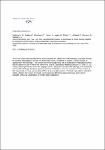Orbus hercynius gen. nov., sp. nov., isolated from faeces of wild boar, is most related to Enterobacteriales and Pasteurellales
Volkmann, Maria
Skiebe, Evelyn
Kerrinnes, Tobias
Faber, Franziska
Lepka, Daniela
Pfeifer, Yvonne
Holland, Gudrun
Bannert, Norbert
Wilharm, Gottfried
A novel gammaproteobacterium, strain CN3T, was isolated from faeces of wild boar. It is facultative anaerobic and appears coccoid or rod shaped. The determined partial 16S rRNA gene sequence of strain CN3T suggests a distant relationship to Enterobacteriales and Pasteurellales. The sequence shows highest similarity of 90.3% with Obesumbacterium proteus DSM 2777T, a member of the Enterobacteriaceae. The closest relatives outside the Enterobacteriales according to 16S rRNA gene sequence analysis are members of the Pasteurellales with 88.7% similarity (Mannheimia haemolytica NCTC 9380T and Actinobacillus lignieresii NCTC 4189T). In contrast to most members of the Enterobacteriales, strain CN3T is oxidase-positive. The pattern of fatty acids, in particular the high relative abundance of C18:1{omega}7c (38.5%), is clearly distinct from the conserved pattern of Pasteurellales. EcoRI ribotyping of strain CN3T yielded no significant similarity to database entries. Major ubiquinone of strain CN3T is Q-8. The DNA G+C content is 36.4 mol%. CN3T hosts a phage and secretes considerable amounts of three proteins into the culture supernatant. A spontaneous mutant of strain CN3T was isolated forming long filaments. Microscopic studies revealed the presence of a capsule which the mutant strain is unable to partition after cell division. CN3T (=DSM 22228T=CCUG 57622T) is considered as the type strain of a novel species within a new genus, for which the name Orbus hercynius gen. nov., sp. nov. is proposed. Its classification to family and order requires further investigation.
No license information

